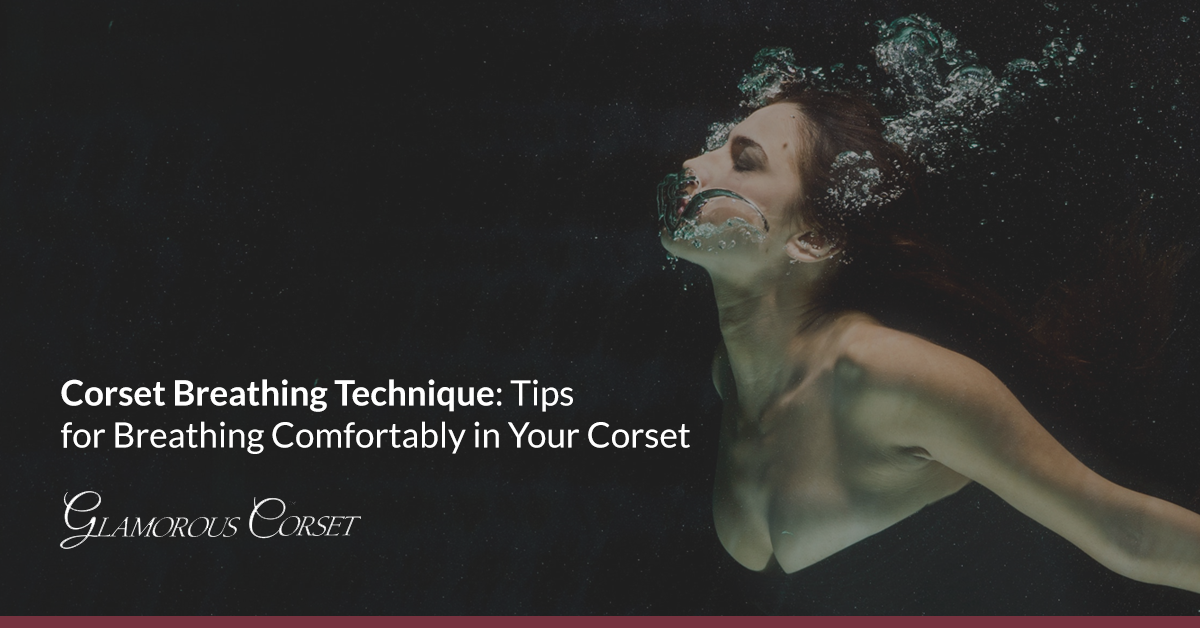Blog
Corset Breathing Technique: Tips for Breathing Comfortably in Your Corset
The trope of the Victorian lady swooning on her fancy fainting couch suggests a certain delicacy of temperament. Or was it a lack of breath from over-tightened corsets? It has long been believed that wearing a corset impacts your ability to breathe, but unless you tightlace before you’re ready, this probably isn’t the case. You simply have to adjust to breathing while wearing this compression garment.
In truth, Victorian women were able to carry on perfectly normal lives while wearing their corsets and long, flowing skirts. Many ran households, rode bicycles, played cricket, and stumped for voting rights, among other things, and they did it all in corsets and heeled boots. They didn’t suffocate where they stood, as some would have you believe.
In other words, you needn’t worry about being short of breath in a corset – you simply need to relearn how to breathe while wearing this support garment. Here are a few tips to help you master the corset breathing technique so you can comfortably go about your day.
Prep Work
If you’ve ever been in choir, chances are you’re aware of the diaphragm, because you probably had a teacher berating you for not using it to strengthen your voice. The diaphragm is a muscle in the upper abdomen that sits just below the lungs. One of its main functions is to create space so that you can fill your lungs with air, or alternately force air out of your lungs. Deep inhalation and exhalation typically involve the diaphragm.
Why is this important? When this muscle is hard at work, helping you to breathe deeply, it forces the ribcage outward to accommodate your lungs as they fill with air. When you’re wearing a corset, however, the ribs are essentially on lockdown – they’re not going anywhere.
Don’t panic. This doesn’t mean you won’t be able to breathe. If corsets cut off your air supply, a whole generation of Victorian ladies would have figured it out almost two centuries ago. So, what gives? Or more to the point, where gives?
Understanding how to breathe in a corset starts with understanding how you breathe without one. If you relax and take a deep breath, your ribcage expands and then settles back as you breathe out. This is because the intercostal muscles that connect your ribs expand to increase the size of the chest cavity. However, you don’t necessarily have to force your ribs outward to breathe.
Try taking a deep breath, but expanding your chest instead of your abdominal area. You can still pull a lot of air into your lungs. This is because your lungs take up a fair amount of space, and while you can inhale all the way to the lower part of the lungs, you don’t necessarily have to.
This is good news for corset wearers, since the lower portion of the lungs will be under some compression once a corset is laced. In truth, most people don’t use their full lung capacity unless they’re running a race or participating in other intensive activity, so maybe don’t wear a corset when running a marathon.
Full, Deep Breaths
Okay, so now you know you can breathe in a corset, but how does it work? While the bones in our body are essentially fixed, the muscles enjoy a lot more flexibility. When you can’t expand your ribcage because the intercostal muscles are restricted by a corset, you’ll have to find another part of the body to move out of the way so that the lungs can expand.
This is where the muscles of the upper torso come into play, including the latissimus dorsi (lats), or back muscles, the trapezius (traps), or shoulder muscles, and the pectoralis (pecs), or chest muscles. When you can’t expand your ribs in the abdominal area to accommodate deep breathing, you can still breathe into your upper torso.
If you’re familiar with the heaving chest sometimes noted in women wearing corsets, this is where it comes from – the expansion of the upper torso to make space for the upper portion of the lungs to expand and fill with air. In short, you can not only breathe normally in a corset, but take deep breaths, if need be.
Taking a Breather
Even when you practice breathing in a corset until you feel comfortable, it’s still possible to forget to breathe as you should. Shallow breathing or bursts of exertion can cause lightheadedness, just as they do when you’re not wearing a corset.
When this occurs, you should take a break to catch your breath. If you were singing or jogging and you started to feel lightheaded or out of breath, you’d sit down, slow your breathing, and take deeper breaths to clear your head. The same applies to breathing in a corset.
If you’ve forgotten to breathe normally in your corset – a not uncommon occurrence for those new to waist training – simply take a breather to return to normal and get back to whatever you were doing with mindful breathing techniques. When you know how to compensate for lost lung capacity in the lower torso, you’ll have no trouble breathing in your corset. Keep the fainting couch for style, though.
Stay up-to-date with weekly blog posts, waist training tips, and the chance to win one of our monthly corset giveaways, like us on Facebook & subscribe to our mailing list today! Want to find the perfect steel boned corset? Shop some of our favorites: underbust corsets, overbust corsets, corset dresses. You can also shop our corsets by material: cotton corsets, denim corsets, leather corsets, mesh corsets, pvc corsets, and satin corsets.

My name is Rachel, I am the owner of Glamorous Corset, a small business founded by me in 2010. Back In 2005, I was in a car accident that left me with a herniated disk. Much to my surprise I learned steel boned corsets were beneficial to several medical injuries including mine. I was always intrigued with corsetry, their history and their beautiful aesthetic. I love sharing knowledge about corsets, educating my wonderful readers and breaking the negative stigma related to corsetry. In combination with my years of research and personal experience I hope my articles are useful and can help anyone who has struggled with some of the same things I have. More about me…


